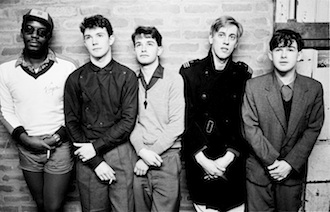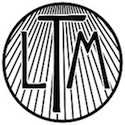A Certain Ratio \ liner notes
Manchester, 1978. In the beginning there were four: Jeremy Kerr (bass), Martin Moscrop (guitar/trumpet), Peter Terrel (guitar/effects) and Simon Topping (vocals/trumpet). Four thin boys with a name borrowed from a Brian Eno record. The intense quartet initially drew influence from Wire, Eno, the Velvets and Kraftwerk. At this point the group had no drummer, but soon gained a manager in Tony Wilson of Factory Records.
Factory issued the first Ratio single in May 1979. All Night Party was suitably dark and brooding, although in August the sound and musicianship of the band would be transformed by the arrival of crack funky drummer Donald Johnson (aka DoJo). Over the next few months the band gigged extensively, often with Joy Division as part of Factory package shows, and recorded demos with producer Martin Hannett as well as a John Peel session. A support slot with Talking Heads on their UK tour in December 1979 confirmed David Byrne on a new course, and provided the compelling live half of stylish a cassette package, The Graveyard and the Ballroom. Post-punk, A Certain Ratio now reflected the influence of Funkadelic, George Clinton, Bootsy Collins, The Bar Kays and James Brown.
The next proper A Certain Ratio record was the epochal Shack Up, released by Factory Benelux in July 1980. Recorded for just £50, the single managed to dent the Billboard disco chart in the USA. Antilles/Island expressed interest in signing the band, who were also invited to record with Grace Jones, but ultimately Ratio elected to remain with Factory and Wilson. In September ACR completed a short American tour with nascent New Order, and collected an extra vocalist in Martha 'Tilly' Tilson. Debut album To Each... was recorded in East Orange, New Jersey, and completed by Hannett at Strawberry in Stockport.
Ratio's third single was the astonishing 12" EP Flight, released in October 1980. Hypnotic, transcendental funk, all three tracks marked ACR as artistic equals of Joy Division. The subsequent live album Live 1980 captures the group at a key point in their development, performing a tight set at the tiny Vera venue at Groningen, in the north of Holland, on the night of 26 October. The show was part of a short Factory package tour of Holland, Belgium and Germany shared with Section 25, as well as The Names and Durutti Column on select dates. Ratio's atypical set betrays a niggling dissatisfaction with playing the same set night after night. Indeed in August ACR had confessed to Paul Morley in NME: "We're not as enthusiastic about what we do as we were at the start. We still like what we're playing, but we play it all the time. We've been on the road for two years now. It doesn't make a difference when you're playing the same old things over and over again. We're in a dilemma at the moment."
Hence this unusual but excellent performance two months later, based largely on tracks from the just-recorded debut album, and ignoring all three singles. The extended, spacier numbers such as Oceans, Loss and Winter Hill sound particularly fine, and the interplay between the dual guitars and trumpets is nothing short of a revelation. Indeed it's something like listening to a crack jazz combo. That this tape exists, and sounds so good, is due largely to live engineer Jon Hurst, whose skill at the mixing desk was consummate.
The European tour in October 1980 would be the last Factory package involving A Certain Ratio, the group having already decided to withdraw their labour from the collective live label effort before their American sojourn. Elsewhere in this booklet you can read an illuminating account of the tour by Larry Cassidy of Section 25, including the shock theft of an ACR trumpet in Amsterdam.
Debut album To Each surprised some on its eventual release in April 1981, in part because many of the best tracks from this period appeared only on singles and EPs. However, the band regained lost ground with their next album, Sextet, and companion single Waterline. Released in January 1982, and self-produced, Sextet attracted rave reviews, and with Tilly as a new live focal point the band took their place in the avant-funk vanguard alongside The Pop Group and 23 Skidoo.
The original Ratio quintet made just one more album, I'd Like to See You Again, cut in February and March 1982. By now Martha Tilson had departed, and Kerr and Moscrop were already working on their latin and jazz chops as members of companion band Swamp Children, soon to be re-invented as Kalima. Ratio's new music offered dry, disciplined latin disco, inspired in part by Cameo. With Tilson gone, however, and Topping content to play trumpet, percussion and keyboards, the band now lacked a willing singer.
When I'd Like to See You Again appeared in October reviews were mixed. According to NME, "ACR aren't sounding like ACR anymore so much as the latest New York disco imports. Is that enough?" The answer was yes, and for the first time ACR were starting to sound like the American acts they took influence from. A short album at just 35 minutes, I'd Like... does nonetheless contain Touch, one of ACR's most durable numbers, while the 7" version of Knife Slits Water (with DoJo on vocals) from the same sessions ranks as one of their finest moments. Moreover the material really shone live, as the extract from a show at The Haçienda on 22 December 1982 included on the Factory Outing video visibly proves.
However, none of this was enough for Peter Terrel, who left in October to travel to India. He was replaced full-time by ace keyboard player Andrew Connell, who had already played live with the band. explains Moscrop: "We'd bought a Moog and a clavinet and all the sort of funk machines, but we didn't have anyone who could really play them." Backing vocalist Carol McKenzie briefly joined, but in March 1983 Simon Topping quit to study percussion in Brooklyn, and later joined Quando Quango, T-Coy and M People, as well as releasing a latin-flavoured solo 12" on Factory Benelux in 1985.
The new look ACR - Connell, Johnson, Kerr and Moscrop - now elected to try for mainstream commercial success. In July 1983 single I Need Someone Tonite revealed this new approach to the public, offering a cover of Stevie Wonder's Don't You Worry Bout a Thing on the flip, though this slick record failed to dent the charts. "We didn't know what we were doing," Kerr admitted later. "After Knife Slits Water we moved more consciously for jazz and latin moods."
"We knew we were shit but we didn't know why..." added Moscrop candidly. "We were listening to a lot of funk records, but we couldn't play like that because they were all from America and they had big record companies and were all petty good musicians. At one time it was out ambition to be as good as them, and that was when we were just trying to be commercial."
After a brace of stop-gap singles at the end of 1984 (Life's A Scream and Brazilia), and now with sax player Tony Quigley on board, a revitalized ACR returned to form in June 1985 with a back to basics double-header, Wild Party and Sounds Like Something Dirty. Connell, Kerr and Moscrop then quit Kalima to concentrate on ACR, and a strong fourth album, Force, followed a year later. But that's another story.
James Nice
March 2005
Official ACR website www.acrmcr.com.





![FORCE [LTMCD 2552]](../images/ltmcd2552.jpg)
![MIND MADE UP [LTMCD 2531]](../images/ltmcd2531.jpg)
![A Certain Ratio - Sextet [FBN 11]](../images/fbn11.jpg)
![A Certain Ratio - I'd Like To See You Again [FBN 17 CD]](../images/fbn17cd.jpg)
![LIVE IN GRONINGEN [HOLLAND] 26.10.1980 [LTMCD 2443]](../images/ltmcd2443.jpg)
![Of Factory New York [FBN 55]](../images/fbn55.jpg)
![AUTEUR LABELS: ROBS RECORDS [LTMCD 2542]](../images/ltmcd2542.jpg)
![UMBRELLAS IN THE SUN [LTMDVD 2400]](../images/ltmdvd2400_330_sq.jpg)
![SHADOWPLAYERS [LTMDVD 2391]](../images/ltmdvd2391_1_330_sq.jpg)